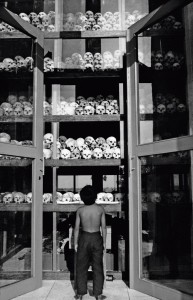When I heard the term “dark tourism” I assumed it was after-hour’s tours and ghost stories. Reading chronologically, I began with Numinous Objects and I thought, “Oh, relics.” From Privates to Presidents disabused me. Appreciating the respect shown by curators, seeing the value derived from collection, (DNA for example) and understanding the historic significance of collection, did not keep me from being mortified that any of it was put on public display or that contents are photographed for family members.
Shades of Dark Tourism showed me that, from an academic standpoint at least, there is a debate about “The curious connection between the sad and the bad and their touristic representations has generated academic and ethical debate about the ways in which leisure and pleasure are mixed with tragedy.”[1]
Swinging between the macabre and the academic, the remaining articles disturbed me so much that I struggled. Are we actually debating “shades of darkness?” This is just another manifestation of our fascination with death and brutality. We watch Jihadi John behead victims, or the execution murder of Robert Godwin, Sr. in Cleveland or the brutalization of an impaired young man by four people in Chicago streamed live on Facebook, Twitter or YouTube. We are fetishizing violence and making money, too. Are we learning about the penal system or penal reform, or just having fun getting our pictures taken inside open cells or in front of gallows? Yeah, you can do both, but that sounds like a rationalization.

Yes, displaying artifacts for scientific or educational purposes can useful. “Bodies: The Exhibition” was educational, but I could barely tolerate being in the presence of these specimens and was shocked to see the lack of respect shown by many attending the exhibition.
Auschwitz may remind us of past atrocities, Robben Island of the indomitability of the human spirit, or the Bastille of revolution, but many such sites only serve to celebrate humanities ability to humiliate, brutalize or dehumanize one another. I saw the interest in dark tourism in opposition to sites like Mount Vernon or Monticello where history is sanitized; slaves are referred to as servants and slave quarters are not displayed because of what they represent. Apparently, that is now seen as a way to attract a new group of visitors. This is exploiting, not honoring the past.
[1] Carolyn Strange and Michael Kempa, “Shades of Dark Tourism: Alcatraz and Robben Island,” Annals of Tourism Research, Vol. 30, No. 2, (April 2002), 387
I was also disturbed by the debate on “darkness.” But I see the “celebratory” aspect of these places differently than you do. I think it is honestly up to the visitor. Most sane people visit these sights or view these exhibits in order to learn something more or to experience a human emotion deeper than what they normally experience. While some people may just be touring a prison in order to get a photo with it, others are imagining being put in a place like this and relating it to the mass incarceration rates in America and what current people are experiencing everyday.
Thank you for your comments. As always they a thoughtful. I agree that many of these sites could be used educationally, but I don’t think many of the fulfill that mission. In part this may be because there is no historian on staff. Another reason is money. As for me, I have visited a number of places that may fall somewhere on the dark spectrum, for example, Gettysburg, Anne Frank’s hiding place, Halabja. When I visit these places I am usually filled with grief and sadness. I have visited the Old Penitentiary, but usually wander around the grounds and have yet to visit the gallows. It is too morbid and I personally find those who are enthralled with these kinds of displays disgusting. Unfortunately, I am afflicted with the ready capacity to put myself in the place of those who are in battle or facing death. The emotional results often overwhelm me. It’s one of the reasons I refuse to watch horror movies and gruesome documentaries. I simply can’t handle it emotionally and can not understand those who seek it out.
I agree Dean that certain places need to be respected and not tarnished by ghost tours. Certain places like Auschwitz should be respected and not be easy to digest for visitors. It was terrible what happened to the Jews their and should be treated with respect as a religious shrine would be. I think in the Southern part of the United States in major historical cities that ghost tours or dark tourism can be used to help raise money and even educate in a non-disrespectful manner. I also agree that sanitizing bad things is exploiting and disrespectful.
I guess my struggle is with the respect part of the whole business. Executing someone is the state demonstrating it’s power over life and death and it is the ultimate humiliation. In a place like Gettysburg, I feel the fear and pain of those going into battle, but shame and humiliation are not part of the context of battle. Halabja reminded me of the Holocaust, but I was disturbed to see the atrocity as almost celebrated. I am not sure I could provide a fixed definition of what I think is appropriate. Beyond saying that it seems okay if it’s educational and respectful. At the same time I could provide examples where it was both and I still was disturbed by it, “Bodies: The Exhibition” is a good example of this. Not sure where to draw the line. Thanks for the comments, appreciate it.